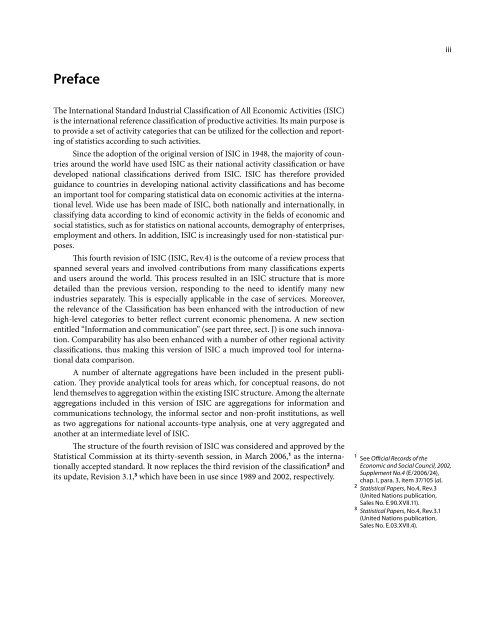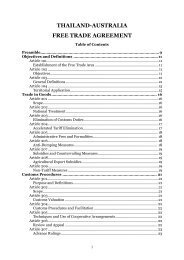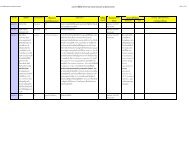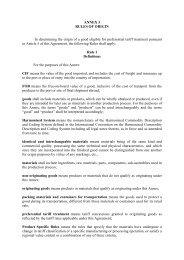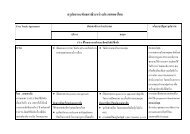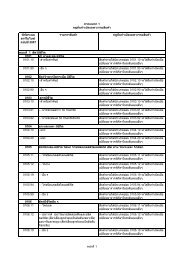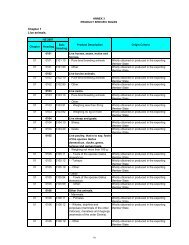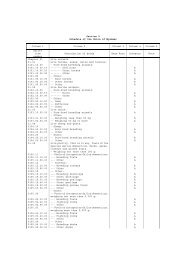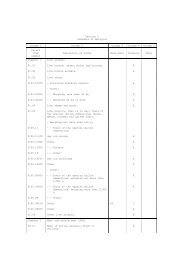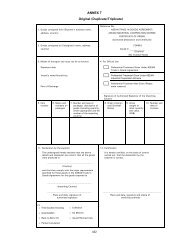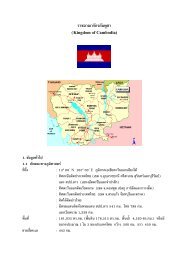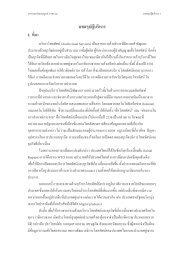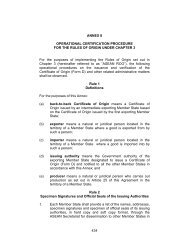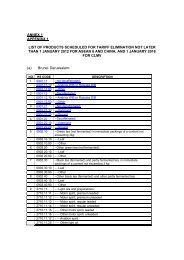International Standard Industrial Classification of All Economic ...
International Standard Industrial Classification of All Economic ...
International Standard Industrial Classification of All Economic ...
- No tags were found...
You also want an ePaper? Increase the reach of your titles
YUMPU automatically turns print PDFs into web optimized ePapers that Google loves.
iii<br />
Preface<br />
The <strong>International</strong> <strong>Standard</strong> <strong>Industrial</strong> <strong>Classification</strong> <strong>of</strong> <strong>All</strong> <strong>Economic</strong> Activities (ISIC)<br />
is the international reference classification <strong>of</strong> productive activities. Its main purpose is<br />
to provide a set <strong>of</strong> activity categories that can be utilized for the collection and reporting<br />
<strong>of</strong> statistics according to such activities.<br />
Since the adoption <strong>of</strong> the original version <strong>of</strong> ISIC in 1948, the majority <strong>of</strong> countries<br />
around the world have used ISIC as their national activity classification or have<br />
developed national classifications derived from ISIC. ISIC has therefore provided<br />
guidance to countries in developing national activity classifications and has become<br />
an important tool for comparing statistical data on economic activities at the international<br />
level. Wide use has been made <strong>of</strong> ISIC, both nationally and internationally, in<br />
classifying data according to kind <strong>of</strong> economic activity in the fields <strong>of</strong> economic and<br />
social statistics, such as for statistics on national accounts, demography <strong>of</strong> enterprises,<br />
employment and others. In addition, ISIC is increasingly used for non-statistical purposes.<br />
This fourth revision <strong>of</strong> ISIC (ISIC, Rev.4) is the outcome <strong>of</strong> a review process that<br />
spanned several years and involved contributions from many classifications experts<br />
and users around the world. This process resulted in an ISIC structure that is more<br />
detailed than the previous version, responding to the need to identify many new<br />
industries separately. This is especially applicable in the case <strong>of</strong> services. Moreover,<br />
the relevance <strong>of</strong> the <strong>Classification</strong> has been enhanced with the introduction <strong>of</strong> new<br />
high-level categories to better reflect current economic phenomena. A new section<br />
entitled “Information and communication” (see part three, sect. J) is one such innovation.<br />
Comparability has also been enhanced with a number <strong>of</strong> other regional activity<br />
classifications, thus making this version <strong>of</strong> ISIC a much improved tool for international<br />
data comparison.<br />
A number <strong>of</strong> alternate aggregations have been included in the present publication.<br />
They provide analytical tools for areas which, for conceptual reasons, do not<br />
lend themselves to aggregation within the existing ISIC structure. Among the alternate<br />
aggregations included in this version <strong>of</strong> ISIC are aggregations for information and<br />
communications technology, the informal sector and non-pr<strong>of</strong>it institutions, as well<br />
as two aggregations for national accounts-type analysis, one at very aggregated and<br />
another at an intermediate level <strong>of</strong> ISIC.<br />
The structure <strong>of</strong> the fourth revision <strong>of</strong> ISIC was considered and approved by the<br />
Statistical Commission at its thirty-seventh session, in March 2006, 1 as the internationally<br />
accepted standard. It now replaces the third revision <strong>of</strong> the classification 2 and<br />
its update, Revision 3.1, 3 which have been in use since 1989 and 2002, respectively.<br />
1 See Official Records <strong>of</strong> the<br />
<strong>Economic</strong> and Social Council, 2002,<br />
Supplement No.4 (E/2006/24),<br />
chap. I, para. 3, item 37/105 (a).<br />
2 Statistical Papers, No.4, Rev.3<br />
(United Nations publication,<br />
Sales No. E.90.XVII.11).<br />
3 Statistical Papers, No.4, Rev.3.1<br />
(United Nations publication,<br />
Sales No. E.03.XVII.4).


